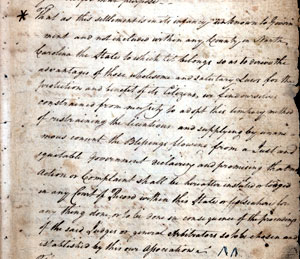
Cumberland Compact
Richard Henderson, land speculator and representative for North Carolina on the western Virginia/North Carolina survey team, drew up the Cumberland Compact in 1780. Signed on May 1, 1780, by 250 men of the new Cumberland settlement, it served as a guide for land transactions and as a simple constitutional government for settlers. With the inclusion of additional provisions on May 13, the compact became the document by which the settlement governed itself until North Carolina created Davidson County in 1783.
The compact called for a representative form of civil government. Each of the seven stations (or forts) of the Cumberland settlement was entitled to a specific number of elected representatives to form a twelve-man “Tribunal of Notables” which dispensed justice, received and dispersed funds, settled claims, and regulated the land office.
In 1775 Henderson privately purchased a large area of land in Kentucky and the part of Tennessee drained by the Cumberland River from the Cherokee Indians. Henderson hoped North Carolina and Virginia would accept this transaction–known as the Transylvania Purchase–and lobbied for the endorsement of the land provisions of the compact by these states. Both North Carolina and Virginia disallowed the purchase and instead granted Henderson several hundred thousand acres of land as compensation. Despite frequent Indian attacks that saw approximately one-third of the original signers of the Cumberland Compact killed in battles with Native Americans by 1784, the Cumberland settlement succeeded.



